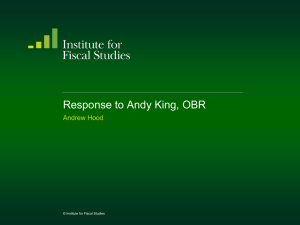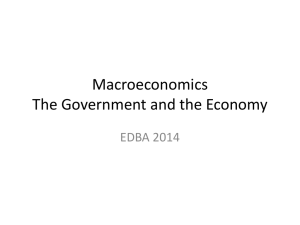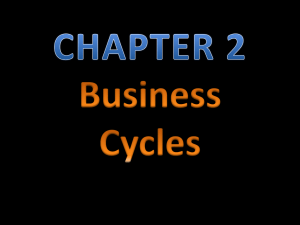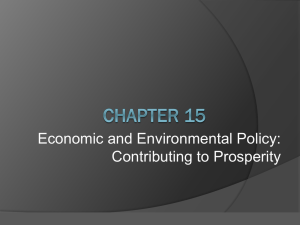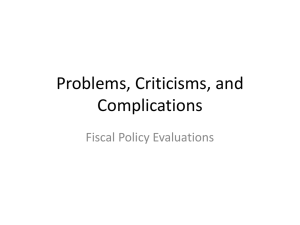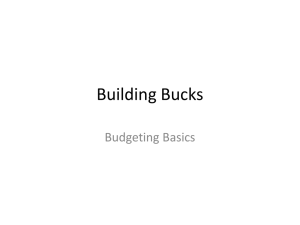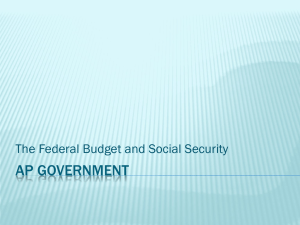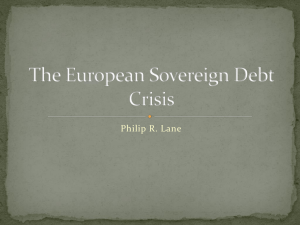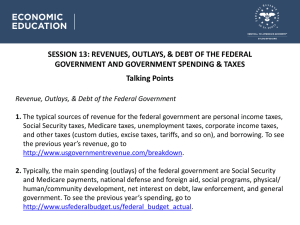Macro_online_chapter_12_14e
advertisement
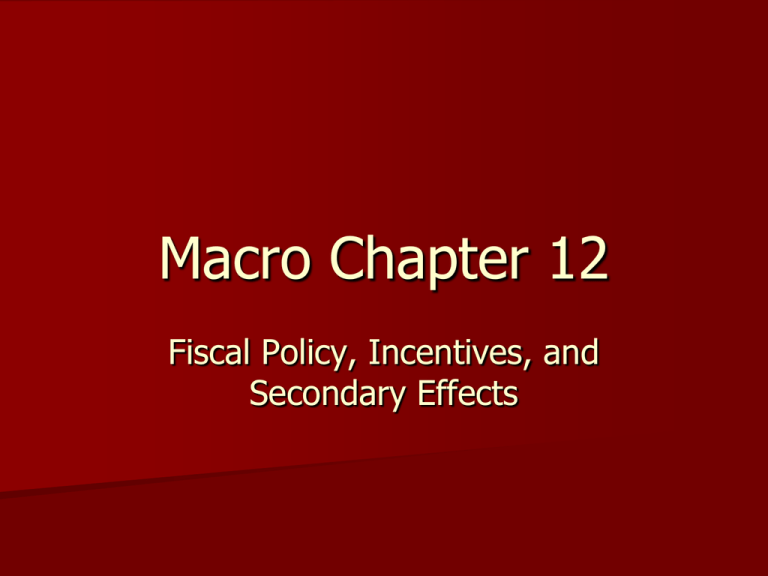
Macro Chapter 12 Fiscal Policy, Incentives, and Secondary Effects Just for fun, watch video Tim Hawkins-The Government Can 4 Learning Goals 1) Explain the crowding-out effect 2) Identify political incentives associated with fiscal policy 3) Investigate the effect fiscal policy has on aggregate supply 4) Summarize both sides of the debate about the effectiveness of fiscal stimulus Fiscal Policy, Borrowing, and the Crowding-Out Effect Basic components of Crowding-Out: Y=C+I+G+X If the government (public sector) spends more, G rises Then businesses, consumers, and foreigners (private sector) spend less; C, I, and X fall Net effect is zero or a small positive increase in Y First Secondary Effect: When the gov’t spends more, it either needs to borrow more or raise taxes to fund that spending If the gov’t borrows more, the demand for loanable funds increases which increases interest rates When interest rates increase, consumers buy less and businesses invest less If the gov’t raises taxes, consumers and businesses have less income which causes C and I to fall Second Secondary Effect: If the gov’t borrows more, the demand for loanable funds increases which increases interest rates Higher interest rates will attract foreign investment which will cause the dollar to appreciate (because the demand for the dollar will increase) When the dollar appreciates, US exports fall and imports rise (net exports fall) Q12.1 The crowding-out model implies that a 1. budget surplus will be highly effective against inflation. 2. budget deficit is likely to stimulate aggregate demand and cause inflation. 3. budget deficit will increase real interest rates and, thereby, reduce private spending. 4. budget surplus will reduce aggregate demand and throw the economy into a downward spiral. Q12.2 The crowding-out model implies that restrictive fiscal policy will 1. increase aggregate demand and employment. 2. lead to a significant increase in the natural rate of unemployment. 3. be highly effective against inflation. 4. reduce real interest rates. Fiscal Policy, Future Taxes, and the New Classical Model Skim on your own You are not expected to know details Political Incentives and the Effective Use of Discretionary Fiscal Policy Luigi Zingales: The main difference between Keynes and modern economics is the focus on incentives. Keynes studied the relation between macroeconomic aggregates, without any consideration for the underlying incentives that lead to the formation of these aggregates. By contrast, modern economists base all their analysis on incentives. John Keynes The General Theory It is my belief that much unnecessary perplexity can be avoided if we limit ourselves strictly to the two units, money and labour, when we are dealing with the behaviour of the economic system as a whole; reserving the use of units of particular outputs and equipments to the occasions when we are analysing the output of individual firms or industries in isolation. The Supply-Side Effects of Fiscal Policy See article “Historical top marginal tax rates” See article “Tax rate schedules 19132011” Tax stories See article “Kamerschen income example with exercise” See article “Mankiw-I can afford higher taxes” Some other details of tax payments Watch video: Stossel Macro 06-how much tax do the rich pay Q12.3 If the government cuts the tax rate, workers get to keep 1. less of each additional dollar they earn, so work effort increases, and aggregate supply shifts right. 2. less of each additional dollar they earn, so work effort decreases, and aggregate supply shifts left. 3. more of each additional dollar they earn, so work effort increases, and aggregate supply shifts right. 4. more of each additional dollar they earn, so work effort decreases, and aggregate supply shifts left. Great Debates in Fiscal Policy Will fiscal stimulus speed recovery from a recession? Argument for Yes: Only some crowding-out will occur so output will increase The multiplier is large so an increase in G will have a big effect Interest rates are weak incentives Will fiscal stimulus speed recovery from a recession? Argument for No: More government spending now will lead to higher interest rates and taxes later Stimulus spending will increase structural unemployment Politically driven spending is inefficient Go to www.recovery.gov to see how and where the 2009 stimulus money was spent Are tax cuts a better tool than government spending? Argument for Yes: Tax cuts work faster Tax cuts are more efficient-you spend your money better than someone else spending it for you Tax cuts are easier to reverse Tax cuts increase the incentive to invest and produce Are tax cuts a better tool than government spending? Argument for No: People will save their money rather than spend it Government spending can be directed to certain areas; tax savings will go different places Government doesn’t want to give up that revenue Q 12.4 Historically, Keynesian economists have argued that government spending will stimulate aggregate demand more than tax cuts because 1. government spending will stimulate aggregate demand more quickly than a tax cut. 2. there are fewer adverse side effects to an increase in government spending. 3. all of the spending will add to aggregate demand, but a portion of the tax cut will be saved. 4. an increase in government spending can quickly be reversed once the economy has recovered. Q12.5 According to non-Keynesians, how will an increase in government spending financed by borrowing during a recession affect recovery? 1. Higher future taxes and interest rates will be required to finance the larger debt and this will weaken the recovery. 2. Repayment of the debt can always be shifted to the future, making it possible to keep tax rates low and thereby strengthen the recovery. 3. Higher interest payments will increase future government spending, and thereby promote a stronger the recovery. 4. The increase in government spending will exert a multiplier effect on the economy, leading to a stronger recovery. U.S. Fiscal Policy and the Great Debate You are seeing the debate unfold before you On January 1, 2009, the national debt was $10.7 trillion. Today, the national debt is $16.2 trillion For numbers overload, visit usdebtclock.org Who does the U.S. owe? See Special Topic 8 The Federal Budget and the National Debt for details The debt is divided into 2 categories: privately held (about 60%) and public (about 40%) Of the privately held debt, about one-half is owned by foreigners "The fact that we are here today to debate raising America 's debt limit is a sign of leadership failure. It is a sign that the US Government cannot pay its own bills. It is a sign that we now depend on ongoing financial assistance from foreign countries to finance our Government's reckless fiscal policies. Increasing America 's debt weakens us domestically and internationally. Leadership means that, "the buck stops here.' Instead, Washington is shifting the burden of bad choices today onto the backs of our children and grandchildren. America has a debt problem and a failure of leadership. Americans deserve better." March, 2006 Senator Barack Obama If you’re more interested: Fiscal stimulus package-Feb 2008 How federal spending has climbed since 2001 US government finance graphs WSJ-Short primer on the national debt WSJ_Wessel-Everything you wanted to know about the budget Watch video: Guide to American federal debt How Much is a Trillion? Inquiring minds want to know What does one TRILLION dollars look like? All this talk about “stimulus packages” and “bailouts”... A billion dollars... A hundred billion dollars... Eight hundred billion dollars... One TRILLION dollars... What does that look like? Here’s a hundred bucks We’ll start with a $100 dollar bill. Currently the largest U.S. denomination in general circulation. Most everyone has seen them, slightly fewer have owned them. Guaranteed to make friends wherever they go. Serious coin A packet of one hundred $100 bills is less than 1/2" thick and contains $10,000. Fits in your pocket easily and is more than enough for a week or two of shamefully decadent fun. One Million Dollars!!! Believe it or not, this next little pile is $1 million dollars (100 packets of $10,000). You could stuff that into a grocery bag and walk around with it. That’s what I’m talkin’ about! While a measly $1 million looked a little unimpressive, $100 million is a little more respectable. It fits neatly on a standard pallet... Holy cow! And $1 BILLION dollars... now we’re really getting somewhere... Please have a seat Next we’ll look at ONE TRILLION dollars. This is that number we’ve been hearing so much about. What is a trillion dollars? Well, it’s a million million. It’s a thousand billion. It’s a one followed by 12 zeros. You ready for this? $1 Trillion dollars: And notice those pallets are double stacked $100 dollar bills! So the next time you hear your Congressman toss around the phrase “trillion dollars”... that’s what they’re talking about. Thomas Jefferson: “A government big enough to give you everything you want is strong enough to take everything you have.” Question Answers 12.1 = 3 12.2 = 4 12.3 = 3 12.4 = 3 12.5 = 1
